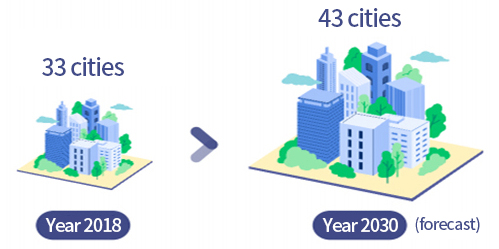(사용안함) What is the Bu-Ul-Gyeong Megacity?
Megacity
- As a metropolitan area connected to enable core city–focused lifestyles, the Bu-Ul-Gyeong Megacity is a megalopolis with a population of 10 million or more and the economic capability to generate globally-focused business.
※ Metropolitan City: City with a population of 1 million or more that acts as the backbone for national and local politics, culture and economic activity
※ City: Center of social, economic and political activity with a population of 50,000 or more
Planning of the Bu-Ul-Gyeong Megacity
- Strategy to develop a single super-regional economic bloc in which Busan, Ulsan and Gyeongnam can live and grow together through the formation of living, economic, cultural and administrative communities, and resolve public problems caused by the population density in the capital area and enhance competitiveness through its global city status.
- The Regulations on the Establishment of Special-purpose Local Governments, based on the completely revised Local Government Act, will serve as the legal foundation of the Bu-Ul-Gyeong Megacity, as well as a means for securing executive action.
※ Special-purpose Local Government
: Special type of local self-governing body established when two or more local governments need to carry out work over a large area for a specific purpose.
Vision
Bu-Ul-Gyeong, as a single team, one of the eight megacities in Northeast Asia,
Core Values
- Tolerance, Prosperity, Sustainability, Quality of life, Safety, Autonomy and Decentralization,
Goals
- Drive policy projects that promote sharing and unity through the “formation” of a living community
- Achieve local and national boost through “realization” of an economic community
- Create a cultural sphere for sharing through the “formation” of a cultural community
- Present a leading model of autonomy and decentralization through the “establishment” of an administrative community
Core Strategy
- Expandability : Strengthen local and national competitiveness
- Identity : Establish a unique identity for the Southeast Region
- Connectivity : Build multi-core functional networks
7 Megacities in Northeast Asia
- Korea: Capital (Seoul)
- China: JING-JIN-JI (Beijing), CHANGJIANG (Shanghai), JIUJIANG (Hong Kong)
- Japan: KINKI (Osaka), CHUBU (Nagoya), KANTÔ (Tokyo)
Global competition is intensifying between metropolitan areas around the world
- Inter-city competition is intensifying according to the increasing megacity trend (33 in 2018→43 in 2030)
- Major advanced countries, such as in the Eurozone and Japan are promoting megacities as a strategy to enhance the competitiveness of their cities.

Excessive concentration in the capital area and intensifying imbalances with non-capital regions
- Accelerated concentration of population, Gross Regional Domestic Product and R&D costs in the capital area

- Information Resource: Statistics Korea (2020)/1000 companies based on sales in 2019, Busan Chamber of Commerce & Industry (2020)/ Credit card usage amount by region (as of 2019), The Bank of Korea
Necessity to establish a strategy for a local New Deal in the Southeast Region in connection with the national Korean New Deal
- Establishment of a response strategy for the Southeast Region’s New Deal following full-scale operation of the national Korean New Deal
- Strengthen power of execution of existing policies
- Establishment of a Southeast Region-wide joint response system and discovery of projects, including Digital and Green New Deals.

What is Bu-Ul-Gyeong?
|
|
Administrative Districts |
|---|---|
|
|
| Surface Area | |
|
Information Resource: Website of Metropolitan City (as of 2020)
Bu-Ul-Gyeong preparing to become a global megacity
- Historical and cultural homogeneity
- Same administrative district since the Three Kingdoms Period
- Patriotic community that fiercely defended the country on battlefields during the Japanese Invasion of Korea in 1592 and the Korean War
- Starting point of pro-democracy movements, such as the Busan-Masan Democratic Uprising
- Formation of a sphere for community life
- External traffic volume by city and province in the Southeast Region
- Close industrial links in the Southeast Region
- Companies that produce and supply shipbuilding-automobile consumption goods
- Supply chain-focused closed networks, including shipbuilding, automobiles, machinery and construction, etc.
- Better than national average capital intensity in future-based car-related companies in the Southeast Region
